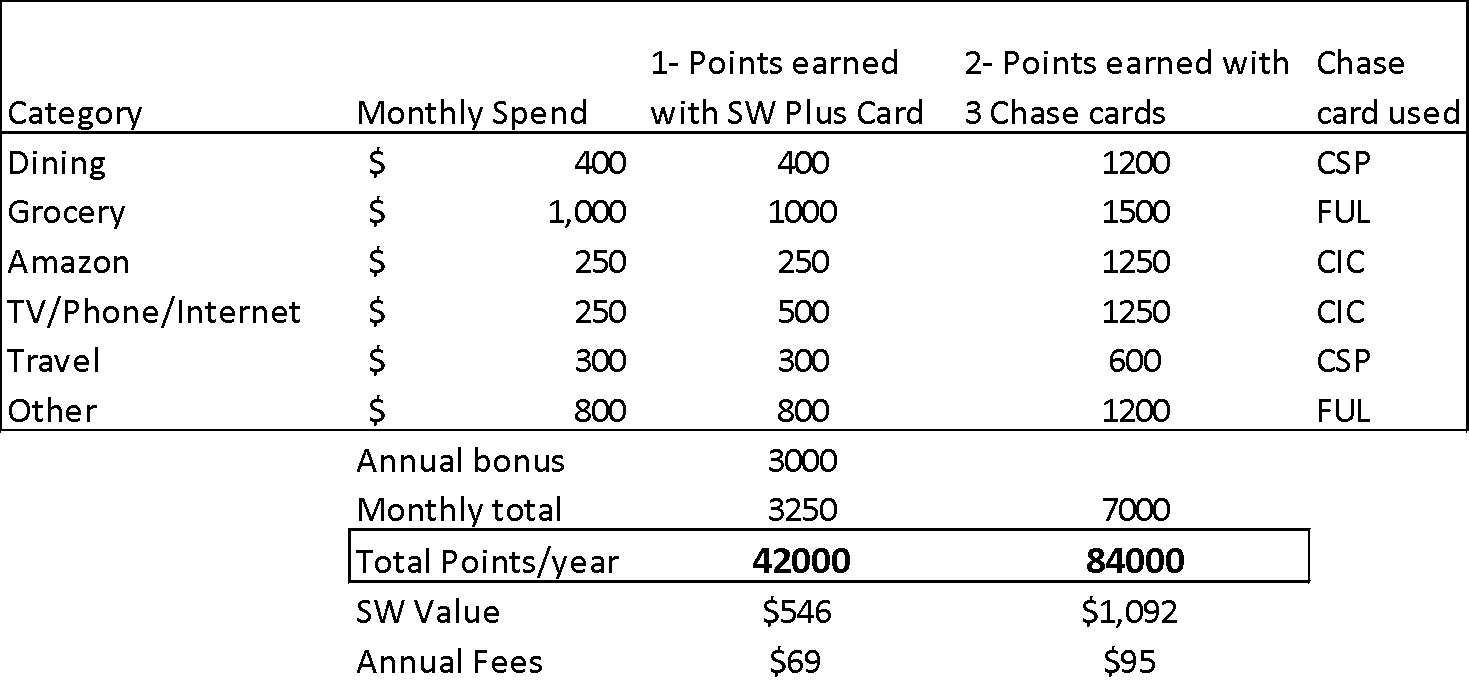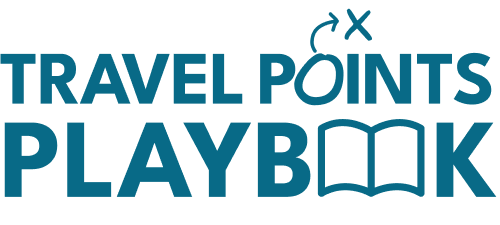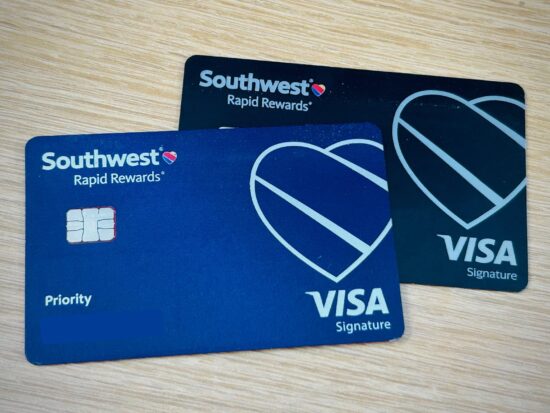One miles and points concept I have seen really confuse people is getting a card but not putting a lot of ongoing spend on it. I often have this exact conversation with many parents on my daughter’s soccer team because we travel around the country so much and often it is flights on Southwest. It can be hard for people to understand the need to get a card and hit the minimum spend, perhaps going for an almost 2-year Companion Pass in the case of the Chase Southwest cards or for the perks of a particular co-brand card such as free checked bags. However, that is very likely not their best option for ongoing spend in order to maximize travel rewards. So many people I know have the Southwest cards and put all or nearly all of their spend on it, and we often have a laugh as I cringe when I see them pull it out to pay for a meal or at a hotel check in.
To help illustrate this point I wanted to take a data-driven approach to investigate just how many points are being left on the table compared to other options. This will really be focused on the ongoing points earning, but I will throw in a few other considerations. I will also add that one card I have tended to keep is the Chase Southwest Rapid Rewards Priority card because the ongoing perks more than make up for the $149 annual fee. With all of the major changes happening at Southwest, I don’t know if the perks will continue to justify the annual fee, but currently I would value them like this:
- 7500 anniversary bonus points (I value at just over $80 after the recent devaluation)
- $75 annual Southwest credit (used to pay taxes on award flights so I value this close to $75)
- 4 free A1-15 boarding position upgrades per year (I don’t value them at face value of ~$40 each but they are worth something, maybe $60-80 total for me personally. Note: these benefits will be changing once Southwest rolls out seating assignments so the value may increase or decrease.)
Obviously, everyone’s situation is different in terms of monthly spend, willingness to apply for and use multiple cards (especially a small business card), and the nuance of the exact spend compared to each card’s bonus categories. For example, the Chase Southwest Rapid Rewards Plus card offers 2X points on local transit, commuting and rideshare and the Chase Sapphire Preferred card offers 5X points on travel booked through the Chase portal.
For this exercise I kept it simple and focused on main categories that families with kids typically spend the most on average. Since we now don’t know the long-term average value of Southwest points, I also assumed an average redemption value of 1.3 cents per point. I think that is likely too generous, but that only further reinforces the outcome!
It can further be argued that the three Chase cards I picked for the 2nd case are not even the best combo to maximize specific earning if your spend tends to be in different categories but I wanted to keep the cards within the Chase family and at a similar level of annual fees to give the most apples-to-apples comparison possible. As they say, YMMV.
Which path is more rewarding?
Whew! With all of that out of the way, let’s dive in. For case one I selected the card with the lowest annual fee of three personal Southwest cards that Chase offers, the Southwest Rapid Rewards Plus ($69 annual fee). For the second case I selected a group of three Chase cards, the Sapphire Preferred ($95 annual fee), the Freedom Unlimited (no annual fee) and the Ink Cash small business card (no annual fee). The latter two are billed as cash back cards but technically earn Chase Ultimate Rewards points. Only when combined with a premium card like the Sapphire Preferred can those points be transferred to travel partners like Southwest. For those new to this hobby that might sound complicated but just know that combining and transferring the points is very easy and can be done in less than 5 minutes. Here are a few key points about each card and the purpose it serves in this case:
- Sapphire Preferred (CSP) – earns 3X on dining, 2X on travel and enables points to be transferred.
- Freedom Unlimited (FUL) – earns 1.5X everywhere, great for “all other” spend, as well as 3X on dining and drugstore purchases
- Chase Ink Cash small business card (CIC) – earns 5X on office supply stores, TV/phone/internet. The 5X at office supply stores is good for gift card purchases like Amazon, Walmart, Home Depot, etc
The monthly credit card spend for families can vary greatly, so for this exercise I chose $3000 of monthly spend across a few main categories. Using the below table, it would be easy to recreate this calculation for your specific scenario if you are someone who uses their Southwest card for daily spending and are curious how many Chase Ultimate Rewards points you could be earning instead. For each category I am showing how many points you would earn with each approach. For example, on TV/phone/internet spend you would earn 2 Southwest points per dollar with the Plus card or 5 Ultimate Rewards points per dollar with the Chase Ink Cash.

Adding up the totals, it works out that with approach 2 using the combination of 3 Chase cards, you would earn exactly DOUBLE the number of points for the same spend! Based on the value, that works out to about a 3% return for that spend ($1,092/$36,000 annual spend, assuming the points are then transferred to Southwest) compared to about a 1.5% ($546/$36,000) return on the Southwest Plus card.
Said another way, why earn an effective 1.5% cash back that you can ONLY spend with Southwest when you could easily earn 1.5-2% cash back that can be spent anywhere via other cards and with no annual fee? Or better yet, consider the Chase 3 card combo and earn and effective 3% back when transferred from Chase Ultimate Rewards to Southwest (not a good value but still higher value than case one)? Or even better yet, why not transfer those points to other transfer partners for even higher value? This last approach is how I spend my Chase Ultimate Rewards points. Two examples of the many great uses of Chase points that jump out at me to illustrate the point would be:
- Up to 16 nights at a level one Hyatt (5k points per night), easily worth $2000
- Round trip flight to Tahiti in economy or US to Europe for as low as 29k points one-way with Virgin Atlantic Flying Club.
The one other argument I have heard is that you can spend your way to Southwest A-list as you receive 1,500 tier qualifying points for every $5k of spend starting in 2024 (was previously $10k of spend!). A-list has some benefits, but most agree the best is that you get checked in automatically and don’t need to rush to check in at exactly 24 hours before your flight in order to get a good boarding position. Is that really worth $120k of spend though, especially with all of the changes coming to Southwest on May 28th? The opportunity cost is massive and, under the current structure, if boarding position is that important it would be easy to make some of that spend on cash back cards and buy Early Bird (auto check in) or buy up to A1-15 boarding positions on the day of the flight for ~$25-40 per ticket. Looking at it another way, for the same $120k of spend, earning 2 points per dollar and redeeming at 2 cents per point would result in $4800 of travel value.
The key point here is that while value is in the eye of the beholder and varies from person to person, it is very tough to argue that putting everyday spend on the Southwest cards makes a lot of financial sense. Will this change once Chase and Southwest roll out the new card benefits later this year? Time will tell, but I am not optimistic.
TL;DR: It is a common misconception to use an airline co-branded credit card for daily expenses such as the Chase Southwest cards. Using a realistic sample monthly spend we proved that you could generate double the number of points with a group of other Chase cards and gain the benefit of multiple transfer partners to maximize travel value.











good information shared really great post